
 For English version please click here
For English version please click here
I pesci chirurgo, in inglese surgeonfishes, abbracciano 3 sottofamiglie, 6 Generi e ben 72 specie. Fanno tutti parte dell’ordine Perciformes, sottordine Acanthuroidei e famiglia Acanthuridae.

Distribuzione di acanturidi in natura, in alto nel blu si vedono Nasi brevirostris, in mezzo si vede un Acanthurus sohal ed in basso si intravede la sagoma di un Acanthurus nigrofuscus
Continua a leggere tutto l’articolo sui pesci chirurgo, sulle cure, le malattie, l’allevamento, l’alimentazione, le varietà e con tante foto, cliccando qua: I pesci chirurgo.
The surgeon fishes cover 3 subfamilies, 6 Genera and 72 species. They are all part of Perciformes Order, suborder Acanthuroidei and family Acanthuridae.
You can discover all about feeding, diseases, aggressiveness, and many and many pictures by clicking here: The surgeonfishes
In acquario sono particolarmente interessanti per la loro bellezza, la semplicità di allevamento, la loro robustezza ed il loro scarso interesse per qualsiasi corallo, sia esso a polipo piccolo, a polipo lungo o molle, anche se raramente è stato osservato un interessamento per alcuni tipi di LPS.
Sono tutti caratterizzati dall’essere compressi lateralmente con una lunga pinna dorsale, una piccola bocca pronunciata, ed un aculeo mobile (o spine immobili). Tutti gli appartenenti a questa famiglia di pesci sono inoltre caratterizzati dall’avere un intestino molto lungo adatto ad una dieta prettamente vegetariana composta principalmente da alghe.
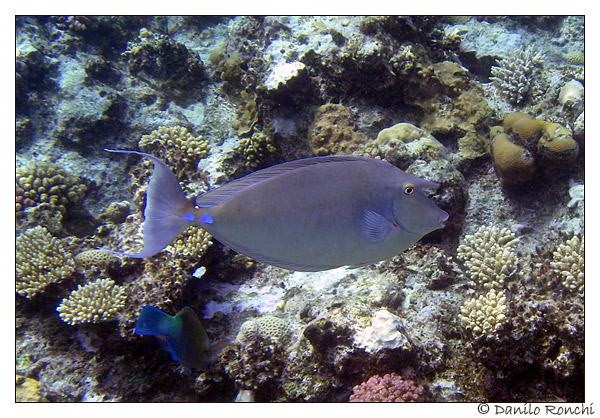
Naso brevirostris nel suo habitat naturale in Mar Rosso
Le 3 sottofamiglie sono facilmente distinguibili dal numero e dalla forma delle pinne caudali. La sottofamiglia Nasinae ha una o due spine fisse. La sottofamiglia Prionurinae ha da 3 a 10 placche ossee ai lati del peduncolo caudale. Mentre la sottofamiglia più estesa e di maggior interesse acquariofilo, l’Acanthurinae, ha una singola spina per parte che rimane aderente al corpo e che può venire estratta per necessità come strumento di offesa o difesa, la famosa lama da cui è nata la dizione “pesce chirurgo”, e che può essere pericolosa anche per gli esseri umani. La maggior parte delle 3 sottofamiglie vive nella barriera corallina o nelle sue immediate vicinanze, in genere nei climi caldi dell’oceano indiano e del pacifico, oltre che nei caraibi e nel mar rosso.
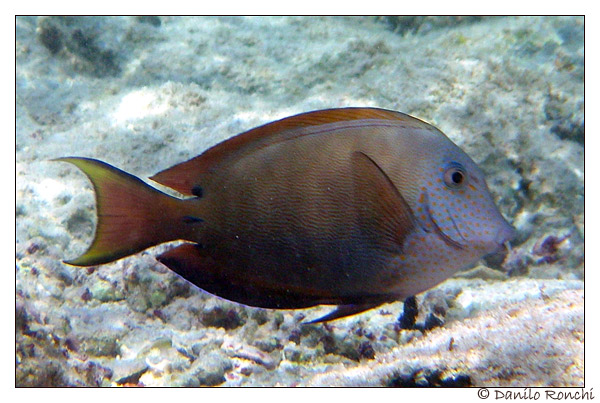
Un bellissimo esemplare di Acanthurus nigrofuscus in mar rosso
Come detto precedentemente sono una delle famiglie di maggior attrattiva acquariofila, sebbene ogni singolo genere abbia delle precise necessità per essere allevato con profitto, tutti i generi hanno bisogno di molto spazio per il nuoto ed una dieta prettamente vegetariana composta soprattutto da alghe vive presenti in acquario. Inoltre hanno bisogno di anfratti dove poter nascondersi se spaventati. Essendo pesci molto attivi nel nuoto gradiscono forti correnti ed un’acqua molto ossigenata, nel nuoto possono infatti raggiungere velocità elevate con il loro caratteristico moto ondulatorio. Per questo motivo è meglio prevedere vasche che abbiano una dimensione fortemente prevalente sull’altra piuttosto che vasche quadrate.
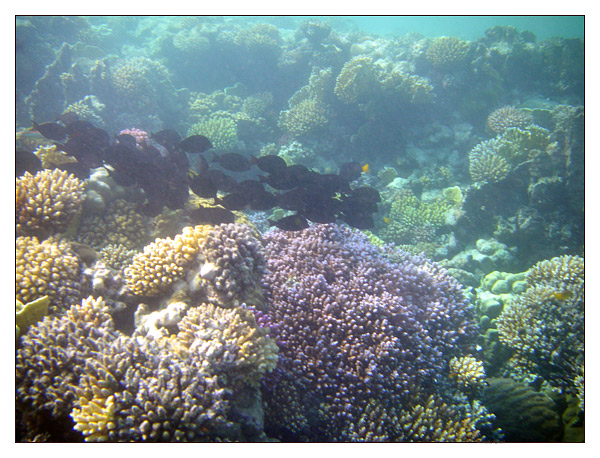
Branco di Acanthurus nigrofuscus in mar rosso
Aggressività
Sono spesso aggressivi con i consimili, soprattutto se hanno livree e colorazioni simili, e soprattutto se l’acquario non è sufficiente a
contenerli entrambi. La loro aggressività aumenta soprattutto dopo che hanno preso possesso della vasca rendendo difficoltoso l’inserimento di altri pesci, soprattutto di taglia simile, dopo il loro completo adattamento. È consigliabile quindi inserire il pesce chirurgo solo come ultimo pesce in acquario, proprio per minimizzare questi conflitti. È altamente sconsigliato tenere due esemplari dello stesso genere in acquario, a meno di non possedere un acquario di dimensioni veramente adeguate, in modo che i pesci possano comportarsi come in natura e quindi scansarsi e fare un lungo nuoto per allontanarsi dai propri consimili.
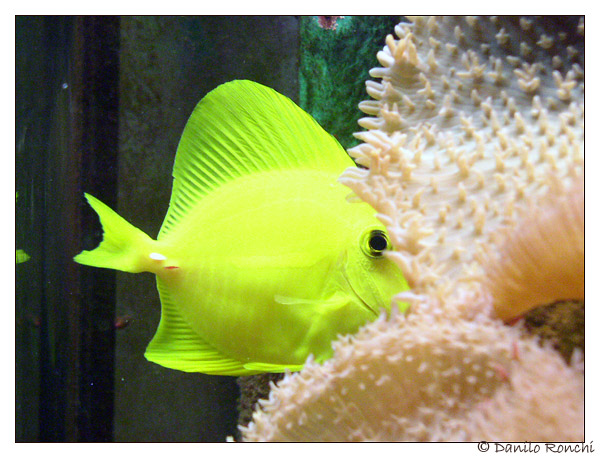
Uno Zebrasoma flavescens mostra nella coda i segni di una lotta contro un A. leucosternon
Alimentazione
I pesci chirurgo, come abbiamo visto, hanno un intestino molto lungo e quindi la loro dieta deve essere composta in maniera massiccia di vegetali. Dopo la loro immissione in acquario, ed una volta acclimatati, si prenderanno cura della maggior parte delle alghe presenti (ma non i ciano batteri e raramente quelle filamentose già lunghe!), in ogni caso è buona norma rifornirli di alghe anche giornalmente usando delle clip per poterle appendere ai vetri. Ottime sostitute alle alghe commerciali, sono le alghe nori che si trovano nei reparti etnici dei supermercati e si usano per preparare il sushi. Oltre alle alghe è importante utilizzare un mangime completo e poco inquinante, meglio se granulato o microincapsulato, e nel caso questo non venisse accettato si consiglia di aggiungere vitamine alle alghe per non indebolire troppo i pesci.
Sconsiglio l’uso della lattuga, che spesso si consiglia per questi pesci, perché composta prevalentemente di acqua e quindi scarsamente nutritiva.
Se scarsamente alimentati questi pesci possono cercare nutrimento spizzicando soprattutto i polipi degli sps, questo non deve essere visto come una loro normale caratteristica ma solo come un bisogno intrinseco di trovare cibo, il problema infatti tende a decadere nel momento in cui si ritorna ad alimentarli regolarmente.
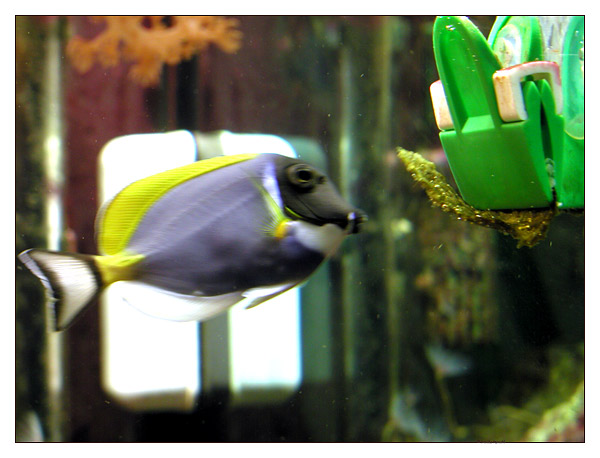
Acanthurus leucosternon molto magro appena introdotto in acquario bruca su alghe appese con una pinza
Malattie
La maggior parte dei pesci chirurgo ha una forte tendenza a mostrare sintomi di malessere in acquario, generalmente dovuti ad un biotopo fortemente inadatto per un litraggio troppo ridotto, mancanza di nascondigli e assenza di substrato su cui poter brucare. I sintomi si esplicano generalmente con la comparsa di malattie dovute a protozoi, come Oodinium e Cryptocarions irritans, che trovano il soggetto debole e quindi lo attaccano. Inoltre il pesce chirurgo potrebbe diventare oltremodo aggressivo, portando anche alla morte pesci più deboli e timidi o pesci di livrea simile, la bellezza di questi pesci non deve infatti trarre in inganno, in quanto possono diventare estremamente cattivi se non ospitati a dovere. Il miglior modo di far regredire questi problemi è agire sulle loro cause, fornendo loro un acquario di dimensioni adatte (raramente un acquario di 300 litri potrebbe andare bene per un singolo pesce chirurgo), con forte movimento ed ossigenazione (consigliato quindi l’uso di uno schiumatoio), una dieta appropriata e la scelta precisa dei compagni da affiancare loro.
Sconsiglio anche la pratica diffusa di comprare un pesce piccolo poiché tanto in acquario “non cresce”. Il fatto che in acquario il pesce non riesca a svilupparsi, significa solo che si sviluppa una patologia che prende il nome di nanismo indotto che non farà altro che aggravare le situazioni sopra descritte. È anche capitato che diversi pesci chirurgo si siano fatti letteralmente morire di inappetenza per questo motivo.
Aggirati tutti questi problemi però il pesce chirurgo rimane un pesce affascinante, un instancabile nuotatore che diventerà docile nei nostri confronti, non è raro infatti incontrare acquariofili che possono accarezzare il proprio chirurgo (pratica ovviamente sconsigliabile a lungo termine per via dei danni che le nostre dita possono procurare alla loro mucosa). Similmente il pesce sviluppa anche una forte intelligenza che si esplica oltre che nel riconoscimento del proprietario anche nell’arrivare ad attirare l’attenzione con frequenti scodate di acqua soprattutto nel momento in cui hanno fame.
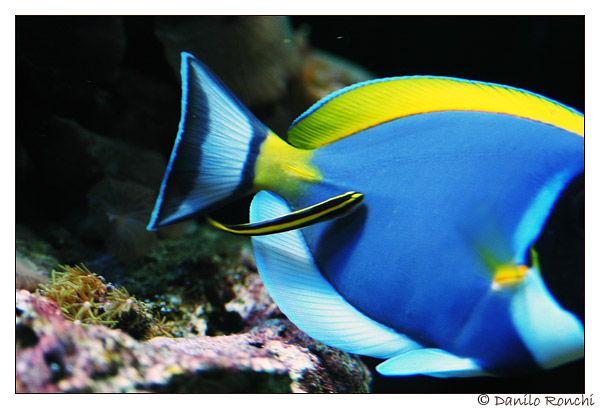
Un Gobiosoma evelynae a caccia di protozoi sulla schiena di un Leucosternon
Una curiosità che accomuna tutti gli acanturidi è che tendono a sbiadirsi se impauriti, se costretti, o se in condizioni ambientali inadatte, è soprattutto facile osservarlo in pesci ben ambientati e coi colori forti, indice appunto di una buona condizione generale, nel momento in cui si inserisce un nuovo ospite soprattutto di forma e livrea simile.
I pesci nel dettaglio
Acanthurus achilles (Achilles tang)
Shaw, 1803
L’achilles è sicuramente uno dei pesci chirurgo più ambiti. Non è sempre semplice trovarlo nei negozi, ed è comunque un pesce molto delicato nella fase di ambientamento, superata la quale, come tutti gli acanturidi diventa longevo e resistente. La splendida livrea è sicuramente un motivo di forte attrattiva in questo pesce, e le dimensioni massime che può raggiungere da adulto lo consigliano anche in vasche relativamente piccole, attorno ai 400 litri, dove comunque ha necessità di avere uno spazio libero in cui nuotare indisturbato. La caratteristica macchia arancione si sviluppa con l’età adulta.
Dimensione massima: 24 cm
Areale di distribuzione: Oceano Indiano e Pacifico
Dimensioni minime della vasca: 400 litri
Temperatura: 26-28°C
Acanthurus japonicus (Japan surgeonfish)
Schmidt, 1931

L’Acanthurus japonicus è uno degli acanturidi più interessanti perché, per via delle sue dimensioni contenute rispetto agli altri pesci chirurghi, può essere ospitato anche in vasche sufficientemente piccole, attorno ai 300 litri. In ogni caso è un pesce che ama farsi notare e che ama prendere possesso della vasca in cui viene ospitato, dove diventa molto territoriale. È altamente sconsigliato ospitarlo con altri pesci simili, soprattutto con l’A. leucosternon.
Dimensione massima: 21 cm
Areale di distribuzione: Oceano Pacifico
Tempo di riproduzione: 15 mesi
Dimensioni minime della vasca: 300 litri
Temperatura: 24-28°C
Acanthurus leucosternon (Powderblue surgeonfish)
Bennet 1833

L’Acanthurus leucosternon, chiamato anche pesce chirurgo dalla gola bianca per via della sua particolare livrea, è uno dei pesci chirurgo più ambiti. Si trova abbastanza facilmente, ma non è un pesce facile da allevare in acquario per via delle sue caratteristiche. In natura infatti ci sono esemplari che arrivano a 54 cm (anche se Scott W. Michael sostiene che si trovino massimo di 23 cm) e quindi che mal si adattano alla vita in una vasca piccola e che non consente loro di poter nuotare a sufficienza, ove tendono a diventare iperaggressivi verso tutti. Anche in natura infatti sono pesci solitari che governano un areale abbastanza ampio e che mal digeriscono le intrusioni altrui. Il periodo di acclimatamento deve essere fatto molto lentamente e con molta cura in quanto il pesce è molto delicato in questa fase e soggetto alle malattie dei protozoi. In qualsiasi vasca lo si vada ad inserire tenderà in breve tempo a diventarne il dominatore assoluto, indipendentemente dagli altri pesci ospitati, grazie alla forza del suo nuoto ed al suo carattere comunque sempre velatamente aggressivo. Verso l’acquariofilo invece l’atteggiamento è docile e sovente è facile che si faccia accarezzare il dorso, e che accetti il cibo direttamente dalle mani.
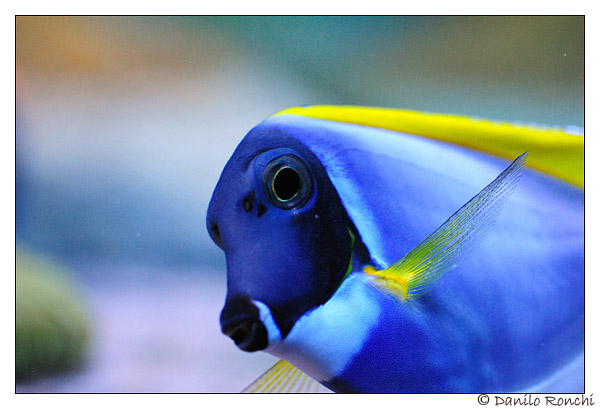
Dimensione massima: 54 cm
Areale di distribuzione: Oceano Indiano
Tempo di riproduzione: 1,4-4,4 anni
Dimensioni minime della vasca: 600 litri
Temperatura: 23-28°C
Acanthurus lineatus (Lined surgeonfish)
Linnaeus, 1758
Fra gli acanturidi è sicuramente il pesce più erbivoro, quello che ha l’intestino più lungo e che quindi necessita di essere nutrito abbondantemente con alghe, anche più volte al giorno, per non deperire, sebbene accetti volentieri anche piccoli crostacei. Sempre in movimento, è dotato di un aculeo velenoso che potrebbe causare il panico anche nelle persone che ne venissero in contatto.
La sua fama fra gli acanturidi è quella di essere uno dei suoi rappresentanti più aggressivi, quindi è altamente sconsigliato tenerlo con altri acanturidi se non in vasche oltremodo spaziose, caratteristica che si trova spesso in chirurghi aggressivi è la sua necessità di avere molto spazio per il nuoto.
Dimensione massima: 38 cm
Areale di distribuzione: Oceano Indiano e Pacifico
Tempo di riproduzione: 1,4-4,4 anni
Dimensioni minime della vasca: 700 litri
Temperatura: 24-30°C
Acanthurus olivaceus (Orangespot surgeonfish)
Bloch & Schneider, 1801
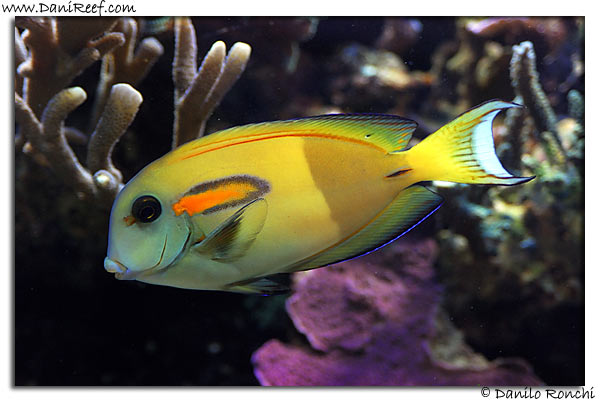
L’olivaceus è un acanturide tendenzialmente pacifico ma che ha bisogno di grandi spazi per nuotare, poiché anche in natura ama nuotare nei pressi della barriera e sopra le rocce. La differenza in livrea fra giovane e adulto è molto pronunciata, con la livrea giovanile molto più apprezzata, visto che la livrea adulta tende a perdere il fondo giallo a favore di un più anonimo fondo grigio. Può capitare in cattività che il pesce non si sviluppi o che arrivi al cambio livrea con notevole ritardo rispetto a quanto succede in natura.
A parte le dimensioni che consigliano una vasca abbastanza ampia, è un pesce chirurgo docile e poco aggressivo, tanto da poter essere ospitato con altri consimili senza nessun problema, a patto che venga inserito per primo per non dover poi lottare contro lo status-quo di un altro pesce. In ogni caso è sicuramente uno dei pesci più semplici da acclimatare, ed è estremamente longevo.
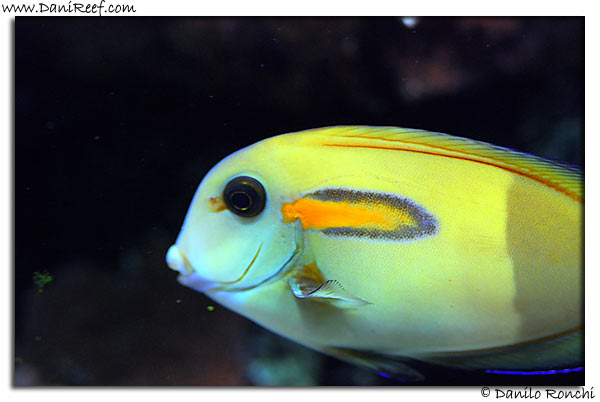
Dimensione massima: 35 cm
Areale di distribuzione: Oceano Pacifico
Tempo di riproduzione: 1,4-4,4 anni
Dimensioni minime della vasca: 500 litri
Temperatura: 24-28°C
Acanthurus piroferus (Mimic surgeonfis)
Kittlitz, 1834
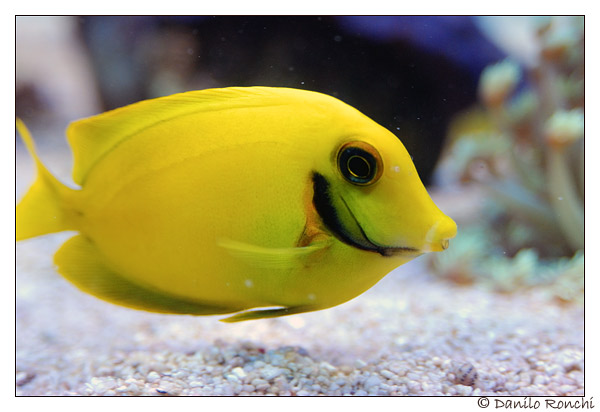
Anche l’A. pyroferus è un chirurgo semplice da tenere in acquario, si accontenta di vasche relativamente piccole (attorno ai 350 litri) e non è di indole aggressiva. Ovviamente valgono tutte le considerazioni fatte sui pesci chirurghi, dalla necessità di avere spazio libero per il nuoto alla dieta vegetale di cui ha bisogno.
Caratteristica peculiare di questa specie, da cui il nome inglese mimic (mimetico) è il fatto che in livrea giovanile può assomigliare fortemente al Centropyge flavissima o al Centropyge vroliki.
In foto si può vedere un esemplare in livrea giovanile.

Dimensione massima: 25 cm
Areale di distribuzione: Oceano Indiano e Pacifico
Tempo di riproduzione: 1,4-4,4 anni
Dimensioni minime della vasca: 350 litri
Temperatura: 24-28°C
Acanthurus sohal (Sohal surgeonfish)
Forsskål 1775
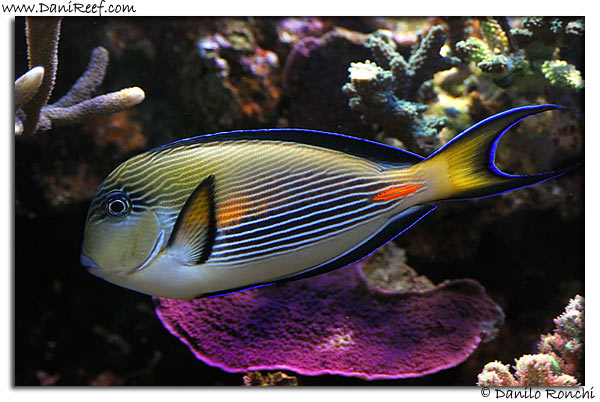
L’Acanthurus sohal è un pesce molto ambito in acquariofilia, per la sua stupenda livrea e per il suo comportamento di instancabile nuotatore. Aggressivo e territoriale in natura vive spesso in grossi banchi ma tenendosi sempre a debita distanza gli uni dagli altri. Anche in acquari relativamente piccoli tende a crescere molto e velocemente, portandolo ad essere molto aggressivo ed insofferente. In natura è solito attaccare anche pesci balestra e pesci pappagallo per difendere il suo territorio. Le pinne caudali sono molto spesse e sovente contengono anche veleno, diventando un’ottima arma di difesa e offesa.
Fatte salve queste considerazioni è un pesce semplice da acclimatare e molto longevo, facile da allevare in cattività, di fondamentale importanza è solo la necessità di ampi spazi. È un ottimo divoratore di alghe filamentose verdi. Proveniente quasi esclusivamente dal mar rosso, viene pescato con le reti e si adatta ad un acqua sicuramente più calda della media, arrivando a sopportare bene anche i 30 gradi. Nei reef tende a vivere sopra la barriera stessa e nei primi metri del mare.
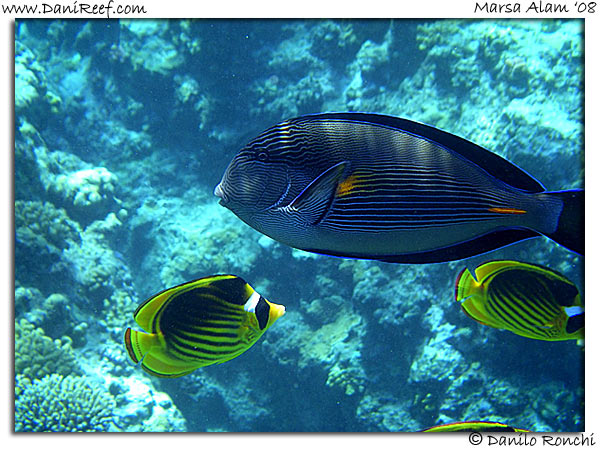
Acanthurus sohal nel mar rosso assieme a Chaetodon lunula
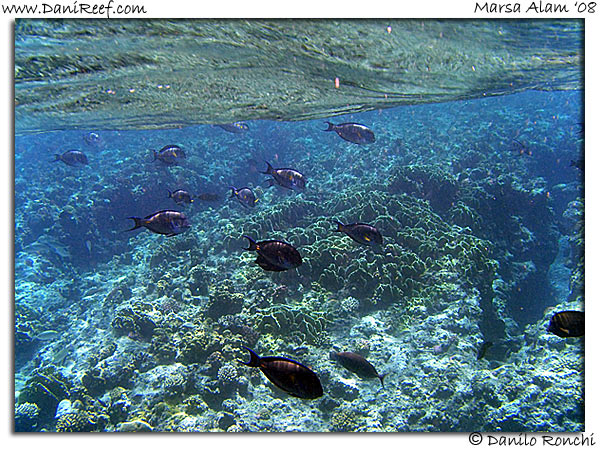
Branco di Acanthurus sohal in mare all’alba, ancora dormienti
Dimensione massima: 40 cm
Areale di distribuzione: Mar Rosso e Golfo Persico
Tempo di riproduzione: 1,4-4,4 anni
Dimensioni minime della vasca: 2,5 – 3 metri di lunghezza, almeno 1000 litri
Temperatura: 24-30°C
Naso Brevirostris (Spotted unicornfish)
Cuvier, 1829
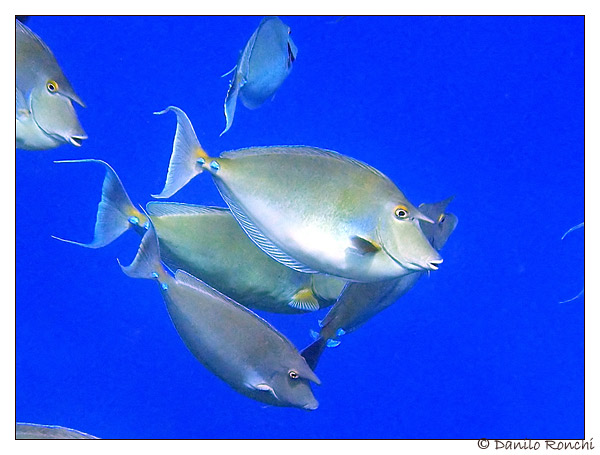
Il Naso brevirostris, spesso indicato anche come Naso unicorno, è endemico dell’area indo-pacifica compreso il mar rosso. Arriva fino a 60 cm ed ama nuotare in branchi. Ovviamente in acquario avrebbe bisogno di una vasca creata appositamente per lui, non inferiore a 1500 litri, anche perché spesso si trova a vivere nei pressi della barriera corallina ma immerso nel blu, dove si possono vedere gruppi di circa 25 esemplari. Il corno cresce con l’età e diventa sempre più lungo. Si nutre di alghe specialmente nell’età giovanile, perché crescendo si ciba soprattutto di zoo-plancton. È stato osservata varie volte in natura la deposizione di uova da parte di una coppia.
La sua indole è oltremodo pacifica e potrebbe quindi essere una forte attrattiva per un acquario particolare, sempre di adeguate dimensioni. Purtroppo è un pesce che tende a saltare fuori dall’acquario, se le dimensioni della vasca non sono congrue.
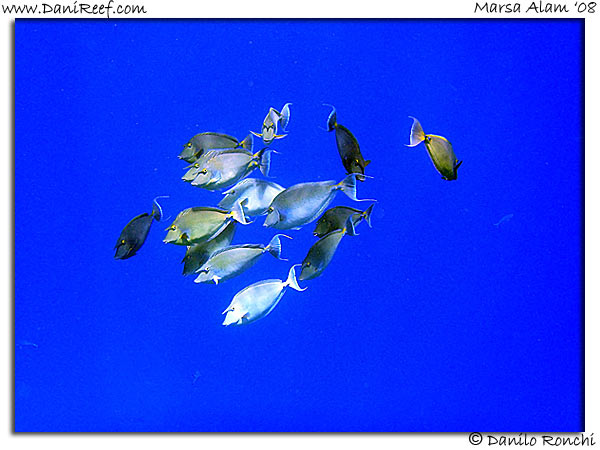
Gruppo di Naso brevirostris nel blu
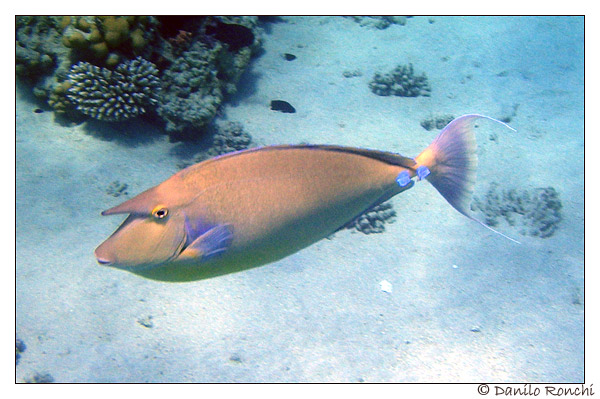
Dimensione massima: 60 cm
Areale di distribuzione: Oceano Indiano e Pacifico, Mar Rosso
Tempo di riproduzione: 1,4-4,4 anni
Dimensioni minime della vasca: 1200 litri
Temperatura: 24-28°C
Naso elegans (Elegant unicornfish)
Rüppel 1829

Il Naso elegans è endemico del mar rosso e dell’oceano indiano, anche se si possono contare avvistamenti fino all’Indonesia, per anni è stato considerato come la variante indiana del naso lituratus, dal quale si distingue per il colore della pinna caudale (gialla) e per una più generale variazione cromatica, degni di nota sono i baffi che partono dalla coda e possono essere lunghi anche diverse decine di centimetri.
In acquario è un forte nuotatore, come tutti i pesci della sua sottofamiglia, ed è un eccellente divoratore di alghe, fra cui le alghe a grappoli come la valonia. Tendenzialmente è un pesce docile e tranquillo, ma date le dimensioni importanti tende a diventare aggressivo in vasche non idonee, chi poi ha avuto la fortuna di vederlo dal vivo, sa che è un pesce che per sua natura sarebbe meglio lasciarlo in mare.
Anche il Naso elegans tende a saltare fuori da acquari non sufficientemente ampii.
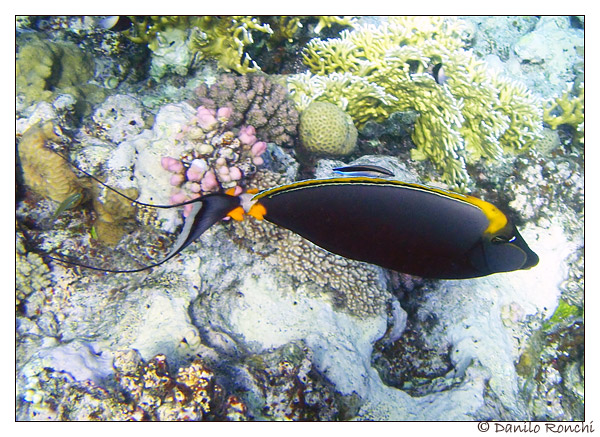
Naso elegans in mar rosso, si noti la coda, impossibile vedere dei baffi così pronunciati in acquario
Dimensione massima: 45 cm
Areale di distribuzione: Oceano Indiano e Mar Rosso
Tempo di riproduzione: 1,4-4,4 anni
Dimensioni minime della vasca: 1000 litri
Temperatura: 24-30°C
Naso lituratus (Orangespine unicornfish)
Forster 1801
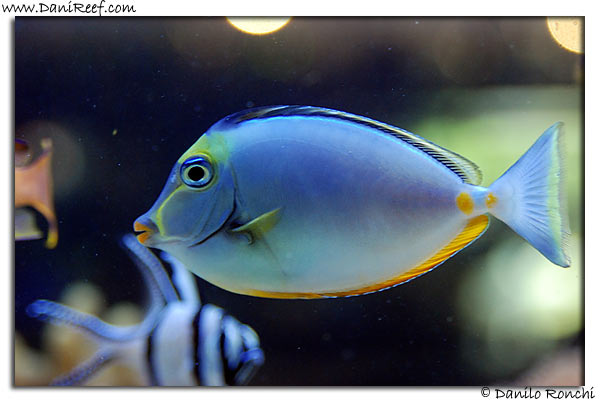
Analogamente al discorso fatto sul Naso elegans, il Naso lituratus è sempre stato considerato come il pesce principale di cui il primo era una semplice varietà, questo perché il suo areale di appartenenza è molto più vasto e si estende principalmente su tutto l’oceano pacifico dal giappone alle isole Hawayii.
In acquario è un forte nuotatore ed è un eccellente divoratore di alghe, fra cui le alghe a grappoli come la valonia. Tendenzialmente è un pesce docile e tranquillo, ma date le dimensioni importanti tende a diventare aggressivo in vasche non idonee, chi poi ha avuto la fortuna di vederlo dal vivo, sa che è un pesce che per sua natura sarebbe meglio lasciarlo in mare.
Come tutti i Nasi tende a saltare fuori da acquari non giudicati idoneei.
Dimensione massima: 46 cm
Areale di distribuzione: Oceano Indiano orientale e Oceano Pacifico
Tempo di riproduzione: 1,4-4,4 anni
Dimensioni minime della vasca: 1000 litri
Temperatura: 24-26°C
Paracanthurus hepatus (Palette surgeonfish)
Linneo 1766
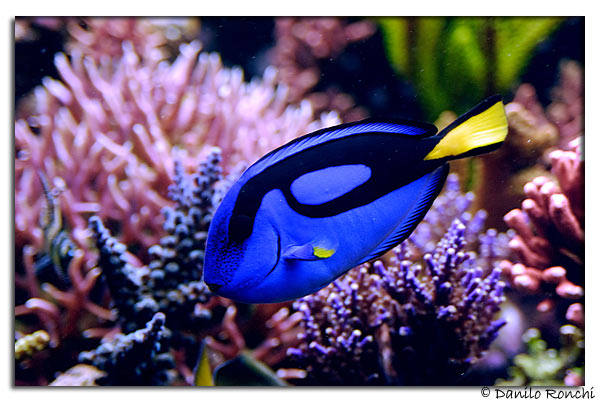
Il Paracanthurus hepatus e sicuramente uno dei pesci chirurgo più comuni in acquariofilia, e la sua popolarità è aumentata a dismisura dopo aver interpretato Dory nel film “Alla ricerca di Nemo”. Pesce socievole e simpatico con comportamenti singolari e molto accattivanti. Dorme spesso su un fianco, sembra litigare sovente con i vetri dell’acquario ed arriva anche a fingersi morto. E’ in ogni caso un instancabile nuotatore. Meno aggressivo della media dei pesci chirurgo, ma molto delicato soprattutto nel momento dell’immissione in acquario. Soffre i pesci molto aggressivi ed è sconsigliato tenerlo assieme ad altri chirurghi di livrea simile con l’Acanthurus leucosternon, mentre ben si accoppia con il genere zebrasoma, fatte salve le dimensioni della vasca. Come per la maggior parte dei pesci è consigliabile introdurlo giovane, ma è sconsigliabile l’acquisto se di dimensioni minime, 1 o 2 cm, in quanto la mortalità è elevatissima.
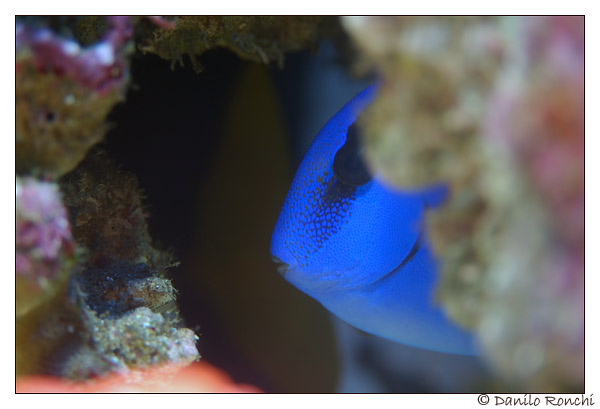
Paracanthurus hepatus nascosto in un anfratto
Dimensione massima: 31 cm
Areale di distribuzione: Oceano Indiano e Pacifico
Tempo di riproduzione: 15 mesi
Dimensioni minime della vasca: 400 litri
Temperatura: 24-26°C
Zebrasoma desjardinii
Bennett, 1836
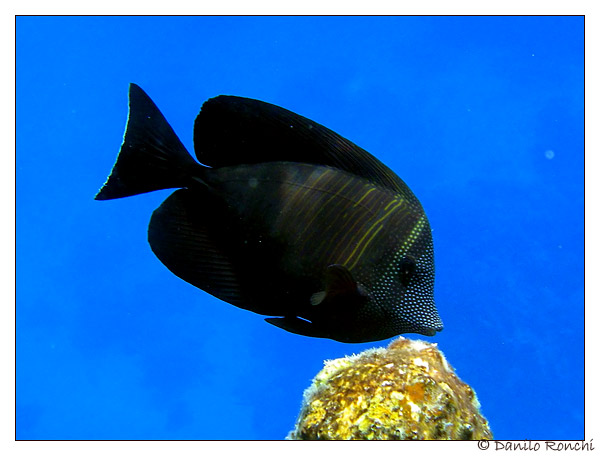
Zebrasoma desjardinii nel mar rosso
Analogamente alle differenze fra Naso elegans e Naso lituratus, lo Zebrasoma veliferum ed il desjardinii sono stati considerati lo stesso pesce per lungo tempo. Da alcuni anni però si considera il veliferum endemico dell’oceano pacifico mentre il desjardinii dell’oceano indiano e mar rosso. Nei veliferum le strisce bianche sono molto più larghe e pronunciate che nel desjardinii dove invece hanno predominanza i puntini più chiari che formano le varie striature del corpo.
Un eccellente pesce d’acquario, a parte le dimensioni, in quanto è pacifico, semplice da allevare, e continuamente alla ricerca di alghe da brucare, per cui è fortemente indicato per tenere sotto controllo la popolazione algale della vasca, è stata anche riscontrato in alcuni esemplari un interesse per alghe a grappolo come la valonia.
Dimensione massima: 40 cm
Areale di distribuzione: Oceano Indiano e Mar Rosso
Tempo di riproduzione: 1,4-4,4 anni
Dimensioni minime della vasca: 500 litri
Temperatura: 24-28°C
Zebrasoma flavescens (Yellow tang)
Bennet 1828
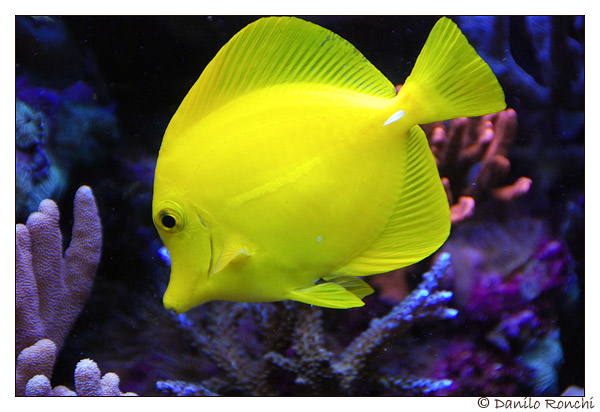
Lo Zebrasoma flavescens è sicuramente il pesce chirurgo più comune e quello che meglio si adatta alla vita in cattività. Il motivo è da ricercare nel fatto che in natura raggiunge la taglia massima di 20 cm, e quindi riesce ad adattarsi e crescere anche in vasche relativamente piccole (raramente inferiori ai 300 litri), e nel fatto che non ama le forti accelerate che invece caratterizzano la sottofamiglia Acanthurinae, ma preferisce un nuoto più placido, caratterizzato dall’ingresso ed uscita degli anfratti presenti. Se allevato in vasche piccole tende ad essere aggressivo, non solo verso i conspecifici ma anche verso tutti gli abitanti dell’acquario, sebbene in natura sia una delle sottofamiglie dei pesci chirurghi che più ama starsene in gruppo. È soggetto spesso alla malattia dei puntini neri che evidenziano in genere una alimentazione non corretta, mentre è soggetto alle malattie dei protozoi come spiegato nell’introduzione. Caratteristica del flavescens è la scoloritura quasi completa che assume la notte nel momento in cui si ritira per dormire, azione che in genere compie all’interno di una insenatura. In quel momento diventa quasi totalmente sbiadito e affiora in superficie una macchia longitudinale bianca, il tutto presumibilmente per mimetizzarsi ed apparire morto ai predatori.

Dimensione massima: 20 cm
Areale di distribuzione: Oceano centro e sud Pacifico
Tempo di riproduzione: 15 mesi
Dimensioni minime della vasca: 300 litri
Temperatura: 24-28°C
Zebrasoma xanthurum (Yellowtail tang)
Blyth 1852
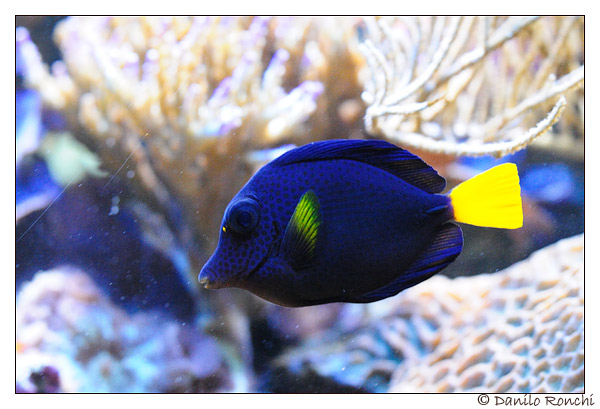
Lo Zebrasoma xanthurum è il più aggressivo del genere Zebrasoma, anche se non arriva a possedere l’aggressività tipica degli acanturidi, è in ogni caso semplice da tenere in vasca e si adatta n molto facilmente, come gli altri suoi fratelli è un instancabile divoratore di alghe, vive in gruppi e quindi è sicuramente più adatto ad essere tenuto in gruppo se la vasca è sufficientemente grande e se vengono inseriti assieme, altrimenti è meglio tenerlo come unico pesce chirurgo in vasca.
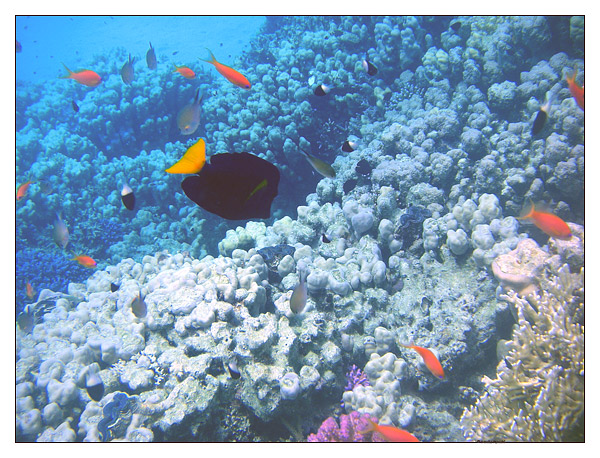
Zebrasoma xanthurum nel mar rosso
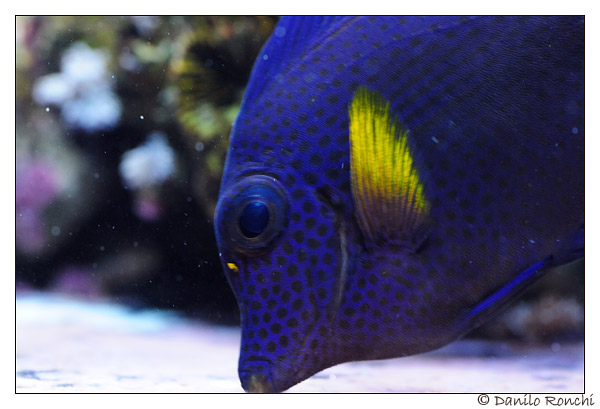
Dimensione massima: 22 cm
Areale di distribuzione: Mar Rosso
Tempo di riproduzione: 15 mesi
Dimensioni minime della vasca: 400 litri
Temperatura: 24-28°C
Zebrasoma veliferum (Sailfin tang)
Bloch, 1795
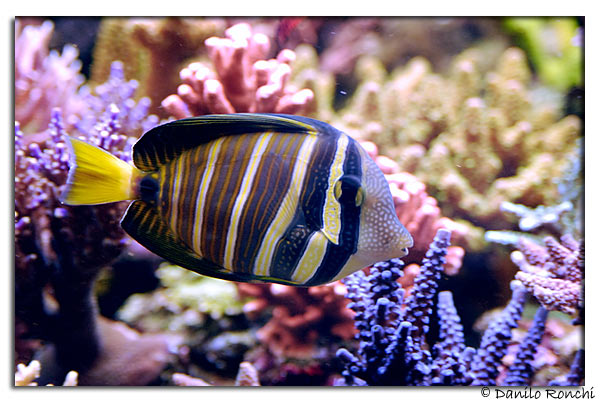
Analogamente alle differenze fra Naso elegans e Naso lituratus, lo Zebrasoma veliferum ed il desjardinii sono stati considerati lo stesso pesce per lungo tempo. Da alcuni anni però si considera il veliferum endemico dell’oceano pacifico mentre il desjardinii dell’oceano indiano e mar rosso. Nei veliferum le strisce bianche sono molto più larghe e pronunciate che nel desjardinii dove invece hanno predominanza i puntini più chiari che formano le varie striature del corpo. L’esemplare ritratto è ancora molto giovane e si notano i caratteri comuni ai due pesci.
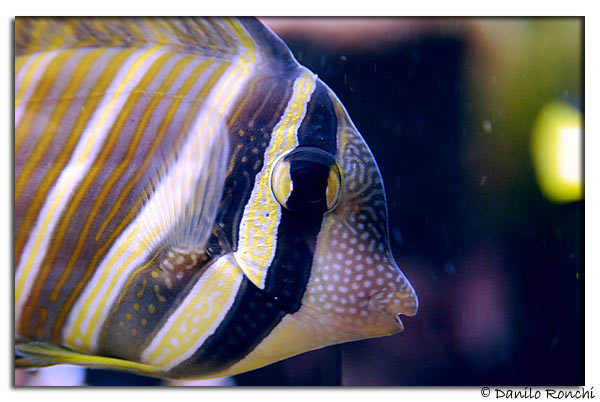
Il veliferum è un pesce molto resistente e molto adatto alla vita in comunità sebbene con la sua mole avrebbe bisogno di una vasca molto capiente per favorirlo al massimo.
L’alimentazione vegetale è fondamentale per evitare che si manifesti l’erosione della linea laterale che lo potrebbe portare alla morte.
Dimensione massima: 40 cm
Areale di distribuzione: Oceano Indiano orientale ed Oceano Pacifico
Tempo di riproduzione: 1,4-4,4 anni
Dimensioni minime della vasca: 500 litri
Temperatura: 24-28°C
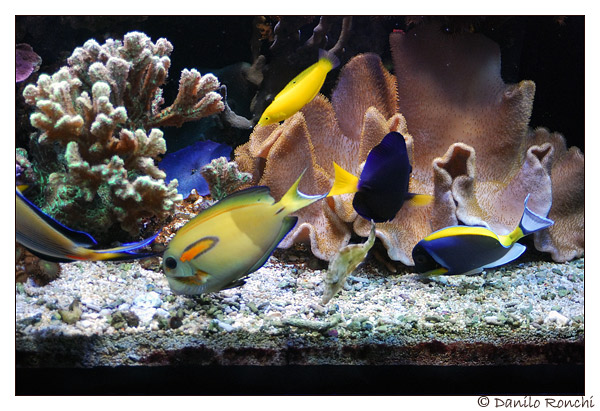
Acanturidi in acquario, si vedono dalla sinistra un A. sohal, un A.olivaceus, uno Z. xanthurum ed un A. leucosternon
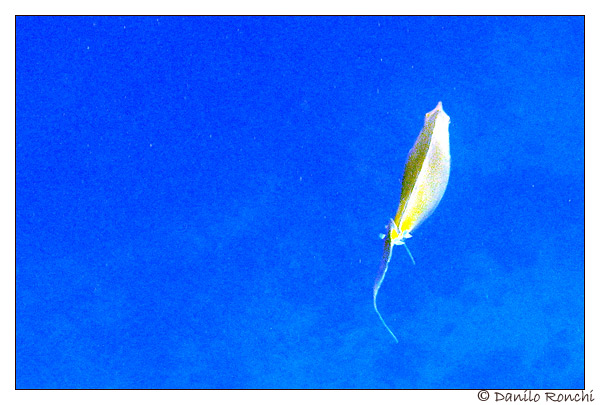
La sagoma di un Naso brevirostris che si allontana nel blu
L’articolo è stato pubblicato su Acquaportal come articolo principale:
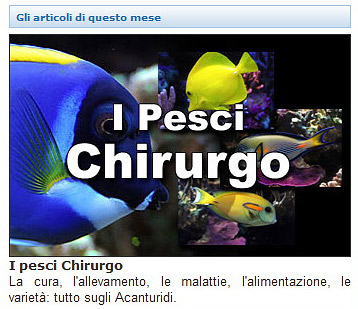
The surgeon fishes cover 3 subfamilies, 6 Genera and 72 species. They are all part of Perciformes Order, suborder Acanthuroidei and family Acanthuridae.

The distribution of surgeonfishes into the wild, high in the blue you see Nasi brevirostris, in the middle you see an Acanthurus sohal and bottom there is the silhouette of an Acanthurus nigrofuscus
In the aquarium are particularly interesting because of their beauty, ease of rearing, their strength and their lack of interest for any coral, whether small polyp, long polyp or softies, although rarely there was a concern for some LPS.
They are all characterized from being compressed laterally with a long dorsal fin, a small mouth pronounced, and a mobile spine (fixed or retractile). All members of this family of fish are also characterized from having a very long intestine adapted to a strictly vegetarian diet consists primarily of algae.

Naso brevirostris in its natural habitat in the Red Sea
The 3 subfamilies are readily distinguishable by the number and shape of the caudal fins. The subfamily Nasinae has one or two fixed spines. The subfamily Prionurinae has 3 to 10 bony plates on the sides of caudal peduncle. While the largest subfamily, and most interesting, the Acanthurinae, has a single spine to the side of body and can be extracted out by necessity as a means of offense or defense, the famous knife from which was born the term “surgeon fish”, and can also be dangerous to humans. Most of fishes of the 3 subfamilies lives in the reef or in its immediate vicinity, usually in warm climates of the Indian Ocean and Pacific, as well as in the Caribbean Sea and in the Red Sea.

A beautiful specimen of Acanthurus nigrofuscus in Red Sea
As mentioned previously this is one of the families most attractive into aquarium, though each gender has a specific need to be farmed profitably, all kinds need a lot of space for swimming and a strictly vegetarian diet consists primarily of algae living in the aquarium . They also need ravines where to hide when frightened. Being very active fish they like to swim in strong currents and highly oxygenated water, in swimming can reach high speeds with their characteristic undulating motion. For this reason it is better to provide tanks with a dimension prevalent on the other rather than square tanks.

Flock of Acanthurus nigrofuscus in Red Sea
Aggressiveness
They are often aggressive with associates, especially if they have similar colors and liveries, and especially if the aquarium is not sufficient to contain them both. Their aggressiveness is increasing especially after they took possession of the tank, making difficult the insertion of other fish, particularly of similar size, after they complete adaptation. You should then insert the surgeon fish just as the last fish in the aquarium, just to minimize these conflicts. It isn’t highly recommended to keep a pair of the same kind in the aquarium, unless you possess an aquarium size really appropriate, so that fish can act as in-kind and thus avoid, and then a long swim to get away from other fishes.

Zebrasoma flavescens shows signs of a struggle in a tail against an A. leucosternon
Feeding
Fish surgeon, as we have seen, have a very long intestine and therefore their diet should be composed in a massive plant. After their release into the aquarium, and once acclimated, will take care of most of the algae present (but not the cyano bacteria and rarely long filamentous!), In each case is a good idea to supply algae daily using clips. You can use commercial algae or nori seaweed that are held in ethnic areas of supermarkets and are used to prepare the sushi. In addition to algae, it is important to use a complete feed and low-polluting, preferably granulated or microencapsulated, and if this is not accepted you are advised to add vitamins to the algae not to weaken too much fish.
Warn against the use of lettuce, which is often recommended for these fish, because it consists mainly of water and therefore poorly nutritious.
If poorly fed these fish may seek nourishment from sps polyps, but this should not be seen as a normal feature but only as an intrinsic need to find food, because the problem tends to fall when you return regularly to feed them.

Acanthurus leucosternon very thin just introduced in the aquarium eats algae hung with clip
Diseases
Most fish surgeon has a strong tendency to show symptoms of malaise in the aquarium, usually due to an unsuitable habitat for a small space, lack of hiding places and absence of substrate on which to graze. Symptoms usually perform with the emergence of diseases caused by protozoa, as Oodinium and Cryptocarions irritans, which find the subject weak. In addition, the surgeon fish could become aggressive, leading even to death the weaker fish and shy fish or similar livery, the beauty of these fish should not be deceived, because they can become very bad if not accommodated properly. The best way to curb these problems is to act on their causes, providing them with an aquarium of suitable size (rarely an aquarium of 300 liters would be acceptable for a single surgeon fish), with strong movement and oxygenation (recommended the use of skimmer), an appropriate diet and the choice of rights mates.
I warn you against the widespread practice of buying a small fish in the aquarium so as “not growing.” The fact that in the aquarium fish can not grow, it means only that you develop a condition known as dwarfism induced. It also happened that several fish surgeon have made literally die of appetite for this reason.
Circumvented these problems the surgeon fish remains a fascinating fish, a tireless swimmer who become docile towards us, it is quite common indeed to meet aquarium keeper that can caress your surgeon (obviously not recommended practice in the long term because of the damage that our fingers could have procured to their mucosa). Similarly, the fish developed a strong intelligence that is expressed not only in recognition of the owner, but also in attracting attention when they put water outside the tank with their tail when they’re hungry.

A Gobiosoma evelynae hunting of protozoa on the back of a Leucosternon
A curiosity that brought together all these fishes is that they tend to fade if frightened, if forced, or in unsuitable environmental conditions, it is especially easy to observe fish in well-set and with strong colors, index exactly a good general condition, when you enter a new host mainly in shape and similar livery.
Fish in detail
Acanthurus Achilles (Achilles tang)
Shaw, 1803
The Achilles is one of the most coveted fish surgeon. It is not always easy to find in stores, and is a very delicate fish in his first days, beyond which, like all surgeonfishes, become wealthy and strong. The splendid livery is certainly reason to strong attraction in this fish, and the maximum size that can reach as an adult requires relatively small tanks, around 400 liters, which still needs to have a space in which to swim undisturbed. The characteristic orange stain develops in adulthood.
Maximum size: 24 cm
Range of distribution: Indian Ocean and the Pacific
Minimum size of tank: 400 liters
Temperature: 26-28 ° C
Acanthurus japonicus (Japan surgeonfish)
Schmidt, 1931

The Acanthurus japonicus is one of the most interesting because, due to its small size compared to other surgeonsfishes may also be housed in tanks sufficiently small, at around 300 liters. In any case it is a fish that likes to get noticed and loves to take possession of the tank in which is housed, where it becomes very territorial. It is not recommended host with other similar fishes, especially with the A. leucosternon.
Maximum size: 21 cm
Range of distribution: Pacific Ocean
Playback time: 15 months
Minimum size of tank: 300 liters
Temperature: 24-28 ° C
Acanthurus leucosternon (Powderblue surgeonfish)
Bennet 1833

The Acanthurus leucosternon is one of the most coveted surgeonfishes. It is a fish easy to breed in aquariums because of its characteristics. In nature there are in fact copies that reach 54 cm (although Scott W. Michael claims that they are up to 23 cm) and therefore ill-adapted to life in a small tank and does not allow them to swim adequately, where they tend to become higly agressive towards all tankmates. Even in nature in fact are solitary fish that govern a wide enough area and don’t want others intrusions. The period of acclimatization should be done very slowly and very carefully as the fish is very delicate at this stage and subject to diseases of the protozoa. In any tank you put it, in a short time tend to become absolute ruler, regardless of the other fish mates, thanks to the strength of his swimming and his character always covertly aggressive. Towards the aquarium’s owner is rather docile and is often easy to caress it, and to accept food directly from the hands.

Maximum size: 54 cm
Range of distribution: Indian Ocean
Playing time: 1,4-4,4 years
Minimum size of tank: 600 liters
Temperature: 23-28 ° C
Acanthurus lineatus (Lined surgeonfish)
Linnaeus, 1758
Among these fishes is certainly the more herbivorous fish, the one that has the longest intestine and therefore needs to be fed with plenty of algae, even several times a day although they gladly accept small crustaceans. Always in motion, has a poisonous sting that can cause panic even in people who were in contact.
His reputation is to be one of its representatives more aggressive, so it’s highly discouraged to keep with others except in very large tanks, a feat that is often found in aggressive surgeons is the need to have much room for swimming.
Maximum size: 38 cm
Range of distribution: Indian Ocean and the Pacific
Playing time: 1,4-4,4 years
Minimum size of tank: 700 liters
Temperature: 24-30 ° C
Acanthurus olivaceus (Orangespot surgeonfish)
Bloch & Schneider, 1801

The olivaceus is a peaceful but need large space to swim, because even into the reef loves to swim around the reef barrier and over the rocks. The difference in livery between young and adult age is very pronounced, with the young livery much appreciated, as the adult tends to lose the yellow background to a more anonymous gray background. It may happen in captivity, the fish will not be developed or come to change livery very late compared to what happens into the wild.
Apart from the dimensions that suggest a fairly large tank, is a surgeon fish and docile little aggressive, so they can be housed with other mates without any problem, if it is placed first for not having to fight against the status-quo of another fish. In any case it is certainly one of the fish easier to acclimatize, and is extremely long wealthy.

Maximum size: 35 cm
Range of distribution: Pacific Ocean
Playing time: 1,4-4,4 years
Minimum size of tank: 500 liters
Temperature: 24-28 ° C
Acanthurus piroferus (Mimic surgeonfis)
Kittlitz, 1834

The A. pyroferus is a surgeon easy to keep in aquariums, are happy with relatively small tanks (around 350 liters) and is not aggressive into the wild. Of course all considerations are similar to ohters surgeonfishes, the need to have free space for swimming and vegetable diet.
Characteristic of this species is the fact that in juvenile livery may strongly resemble the Centropyge flavissima or Centropyge vroliki.
In pictures you can see a sample of youth in livery.

Maximum size: 25 cm
Range of distribution: Indian Ocean and the Pacific
Playing time: 1,4-4,4 years
Minimum size of tank: 350 liters
Temperature: 24-28 ° C
Acanthurus sohal (Sohal surgeonfish)
Forsskål 1775

The Acanthurus sohal is a wonderful fish, wide available, because of its beautiful livery and for his tireless swimmer behavior. Aggressive and territorial in nature often live in large shoals, but always keeping a safe distance from each other. Even in relatively small aquaria tend to grow very quickly and bringing it to be very aggressive and impatient. In nature it is also usually to attack parrotfishes and triggerfishes to defend its territory. The caudal spines are very thick and often also contain poison, becoming an excellent weapon for defense and offense.
Other than these considerations is a fish easy to acclimatize and very durable, easy to breed in captivity, of fundamental importance is only the need for large spaces. It is a great devourer of filamentous green algae. Comes almost exclusively from the Red Sea, is caught in the nets and can be adapted to a far more warm water of the average, going to support even 30 degrees. In the reef tends to live above the barrier and the first meters of the sea.

Acanthurus sohal and Chaetodon lunulata in Red Sea

Flock of Acanthurus sohal at dawn, still dormant
Maximum size: 40 cm
Range of distribution: Red Sea and Persian Gulf
Playing time: 1,4-4,4 years
Minimum size of tank: 800 liters
Temperature: 24-30 ° C
Naso brevirostris (Spotted unicornfish)
Cuvier, 1829

The Naso brevirostris, often also referred to as Naso unicorn, is endemic in the Indo-Pacific including the Red Sea. Up to 60 cm and loves to swim in flocks. Obviously in the aquarium would need a tank made for him, not less than 1500 liters, partly because they often have to live near the reef but surrounded by the blue, where you can see groups of about 25 mates. The horn grows with age and becomes increasingly long. It feeds on algae, especially during youth, because growing mainly eats zoo-plankton. It has been observed several times of egg deposition by a couple.
His character is very peaceful and could therefore be a strong attraction to a particular aquarium, always of sufficient size. Unfortunately, it is a fish that tends to jump out from aquarium, where the size of the tank is not adequate.

Naso brevirostris group in blue

Maximum size: 60 cm
Range of distribution: Indian Ocean and the Pacific, Red Sea
Playing time: 1,4-4,4 years
Minimum size of tank: 1200 liters
Temperature: 24-28 ° C
Naso elegans (Elegant unicornfish)
Ruppel 1829

The Naso elegans is endemic of Red Sea and Indian ocean, even if you can count sightings up to Indonesia, for years was regarded as the Indian variant of the Naso lituratus, which is distinguished by the color of the caudal fin (yellow) and a wider variation of colors, worthy of note are the mustache departing from the tail that can be long several centimeters.
In the aquarium is a strong swimmer and it is a great devourer of algae, including balloon seaweeds like Valonia. This fish tend to be a docile and quiet, but, given his size, tends to become aggressive in tanks unfit, who then had the good fortune to see him live, he knows that is a fish which by its nature would be better to leave in the sea.
The Naso elegans tends to jump out of aquariums are not sufficiently adequate.

Naso elegans in the Red Sea, note the tail, we could not see the mustache so pronounced in aquarium
Maximum size: 45 cm
Range of distribution: Indian Ocean and Red Sea
Playing time: 1,4-4,4 years
Minimum size of tank: 1000 liters
Temperature: 24-30 ° C
Nose lituratus (Orangespine unicornfish)
Forster 1801

Like Naso elegans, the Naso lituratus has always been regarded as the main fish of which the first was a simple variety, because its range of membership is much broader and extends mainly over the Pacific Ocean from japan to islands Haway.
In the aquarium is a strong swimmer and it is a great devourer of algae, including balloon seaweeds like Valonia. This fish tend to be a docile and quiet, but, given his size, tends to become aggressive in tanks unfit, who then had the good fortune to see him live, he knows that is a fish which by its nature would be better to leave in the sea.
Like all Nasi tends to jump out of aquariums are not sufficiently adequate.
Maximum size: 46 cm
Range of distribution: Indian Ocean and eastern Pacific Ocean
Playing time: 1,4-4,4 years
Minimum size of tank: 1000 liters
Temperature: 24-26 ° C
Paracanthurus hepatus (Palette surgeonfish)
Linnaeus 1766

The Paracanthurus hepatus and certainly one of the most common surgeonfishes in aquarium, and its popularity has increased dramatically after interpreted Dory in the film “Finding Nemo”. Sociable and friendly fish with unique behavior and very appealing. Often sleeps on one side, it seems often quarrel with the glass of the aquarium and sometime to pretend to be dead. It’s a tireless swimmer. Less aggressive of the average surgeonfishes, but very delicate especially when they are placed in the aquarium. Suffers very aggressive fishes and is not recommended to keep it together with other surgeonfishes with similar livery like the Acanthurus leucosternon, while it matches well with the Zebrasoma genus, except the size of the tank. As with most fishes it is advisable to introduce as young as you can, but it is inadvisable if the purchase of a minimum size, 1 or 2 cm, because the mortality is very high.

Paracanthurus hepatus hidden
Maximum size: 31 cm
Range of distribution: Indian Ocean and the Pacific
Playback time: 15 months
Minimum size of tank: 400 liters
Temperature: 24-26 ° C
Zebrasoma desjardinii
Bennett, 1836

Zebrasoma desjardinii in Red Sea
Like the differences between the Naso elegans and Naso lituratus, there are Zebrasoma veliferum and desjardinii, and were considered the same fish for a long time. From several years, however, we consider the veliferum from Pacific Ocean while the desjardinii of the Indian Ocean and Red Sea. In veliferum the white stripes are very wide and more pronounced than in desjardinii where we can see the dots that make clearer the various veins of the body.
An excellent aquarium fish, apart from the size, as it is peaceful, easy to breed, and constantly in search of algae to graze, so it is strongly indicated to control the algal population of the tank, was also found to have sometimes a little interest on bubble algae Valonia.
Maximum size: 40 cm
Range of distribution: Indian Ocean and Red Sea
Playing time: 1,4-4,4 years
Minimum size of tank: 500 liters
Temperature: 24-28 ° C
Zebrasoma flavescens (Yellow tang)
Bennet 1828

The Zebrasoma flavescens is certainly the most common surgeonfish and one that best adapts to life in captivity. The reason lies with the fact that naturally reaches the maximum size of 20 cm, and therefore able to adapt and grow in relatively small tanks (rarely less than 300 liters), and the fact that he does not like the strong swim that characterize the subfamily Acanthurinae, but prefers a more peaceful swim, marked the entrance and exit of these ravines. If reared in small tanks tend to be aggressive, not just on similar tank mates but also towards all the inhabitants of the aquarium, although in nature is one of the surgeonfishes subfamilies that like to stay in groups. It is often subject to disease of black dots that show a poorly feeding, while subject to diseases of the protozoa as explained in the introduction. Flavescens feature is the almost complete color loosing holding the night when they retired to sleep. At that time it becomes almost completely faded and the surface area in a longitudinal white stain, all presumably for camouflage and appear dead to predators.

Maximum size: 20 cm
Areal distribution center Ocean and South Pacific
Playback time: 15 months
Minimum size of tank: 300 liters
Temperature: 24-28 ° C
Zebrasoma xanthurum (Yellowtail tang)
Blyth 1852

The Zebrasoma xanthurum is the most aggressive of the genus Zebrasoma, even if you do not get to have the aggressiveness typical of acanthurus, bu this apart is easy to take in a tank and fits in very easily, as his other brothers is a devourer of tireless algae, living in groups and thus is more suitable to be kept in groups if the tank is large enough and if they are placed together, otherwise it is better to keep it as the only surgeon in the fish tank.

Zebrasoma xanthurum in Red Sea

Maximum size: 22 cm
Range of distribution: Red Sea
Playback time: 15 months
Minimum size of tank: 400 liters
Temperature: 24-28 ° C
Zebrasoma veliferum (Sailfin tang)
Bloch, 1795

Like the differences between the Naso elegans and Naso lituratus, there are Zebrasoma veliferum and desjardinii, and were considered the same fish for a long time. From several years, however, we consider the veliferum from Pacific Ocean while the desjardinii of the Indian Ocean and Red Sea. In veliferum the white stripes are very wide and more pronounced than in desjardinii where we can see the dots that make clearer the various veins of the body. The sample picture is still very young and you see the characters of both fish.

An excellent aquarium fish, apart from the size, as it is peaceful, easy to breed, and constantly in search of algae to graze, so it is strongly indicated to control the algal population of the tank, was also found to have sometimes a little interest on bubble algae Valonia.
The algae feeding is crucial to avoid the erosion of the lateral line that could lead to death.
Maximum size: 40 cm
Range of distribution: Indian Ocean and eastern Pacific Ocean
Playing time: 1,4-4,4 years
Minimum size of tank: 500 liters
Temperature: 24-28 ° C

Acanthurus into aquarium, from left A. sohal, A.olivaceus, Z. xanthurum and A. leucosternon

The silhouette of a Naso brevirostris that swim to the blue



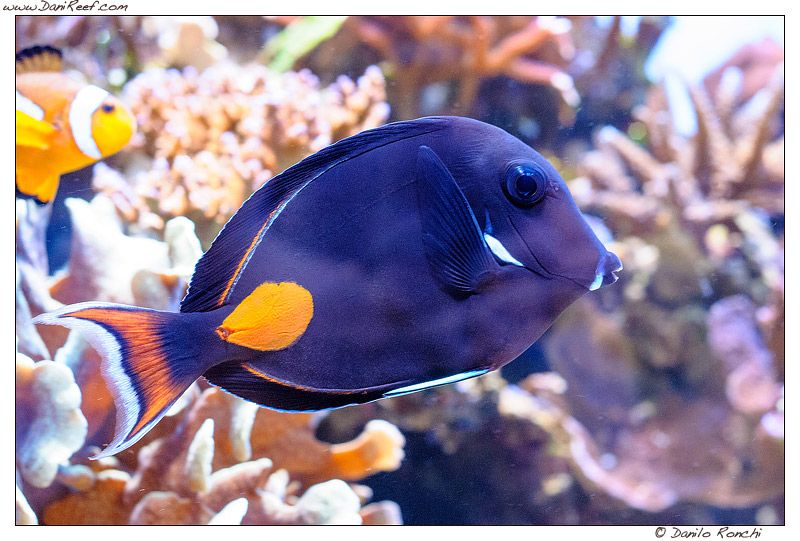


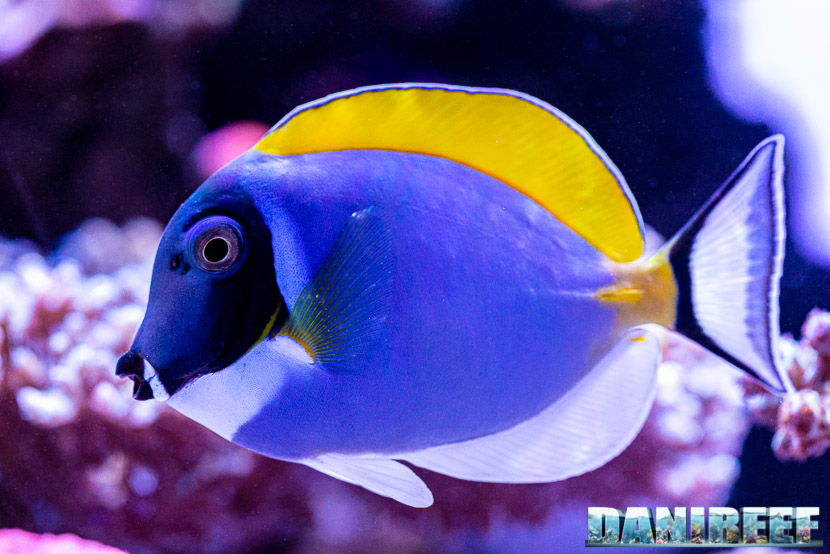
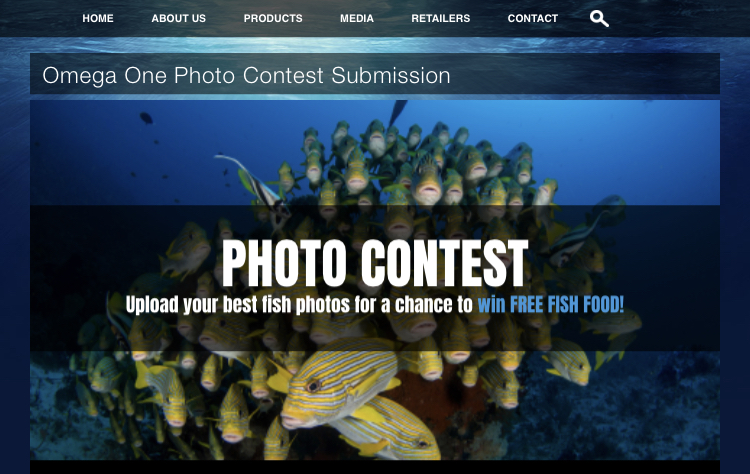


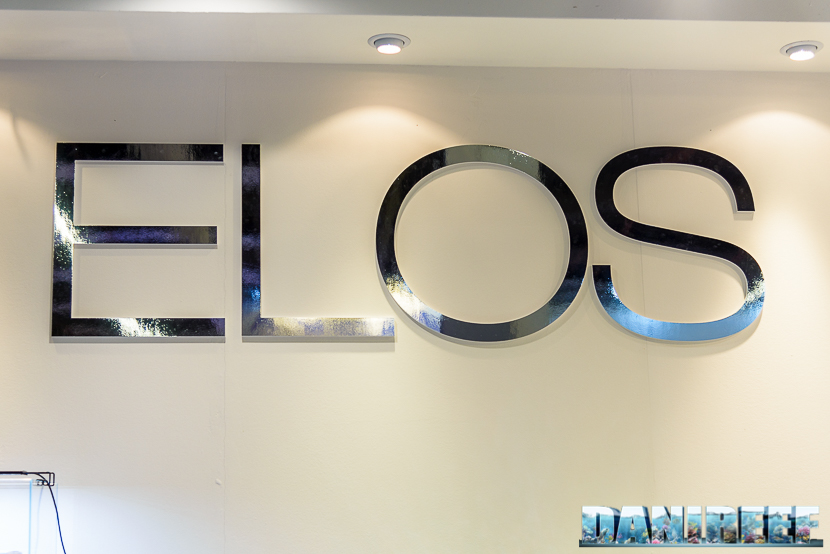
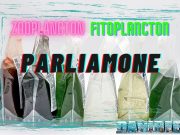

Be… le foto sono come al solito spendide.
Apprezzi molto questa specie di pesci, giusto dani?
[…] “The Surgeonfishes” – A great article by our favorite reefer out of Europe, Danilo. Covers many common […]
[…] Approfondimento: I pesci Chirurgo […]
[…] diffusi pesci d’acquario per genere. Abbiamo già parlato dei pesci chirurgo qualche anno fa (leggi l’articolo sui pesci chirurgo) ed oggi vogliamo cominciare a parlarvi della famiglia dei Pesci Angelo, cominciando con il […]